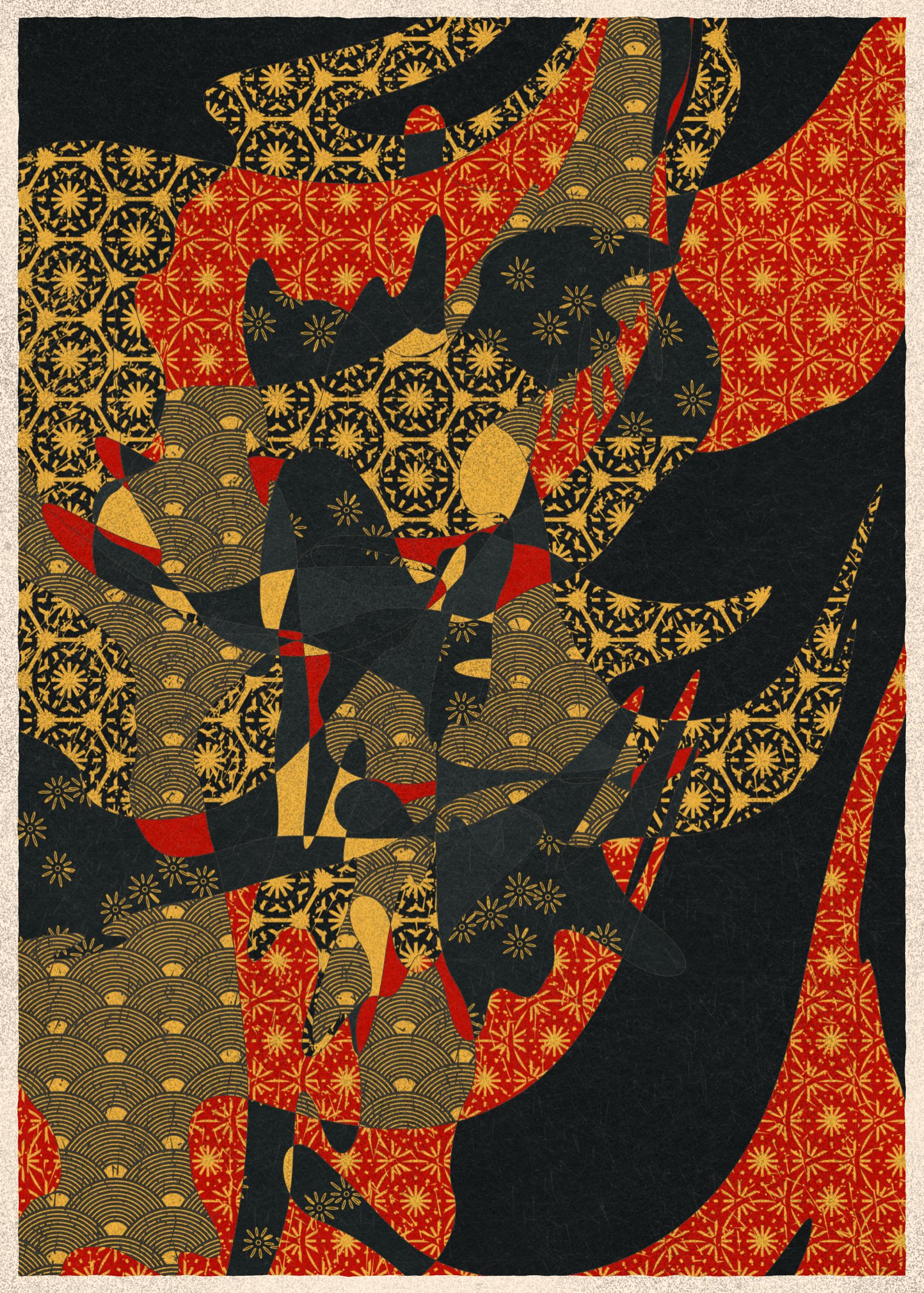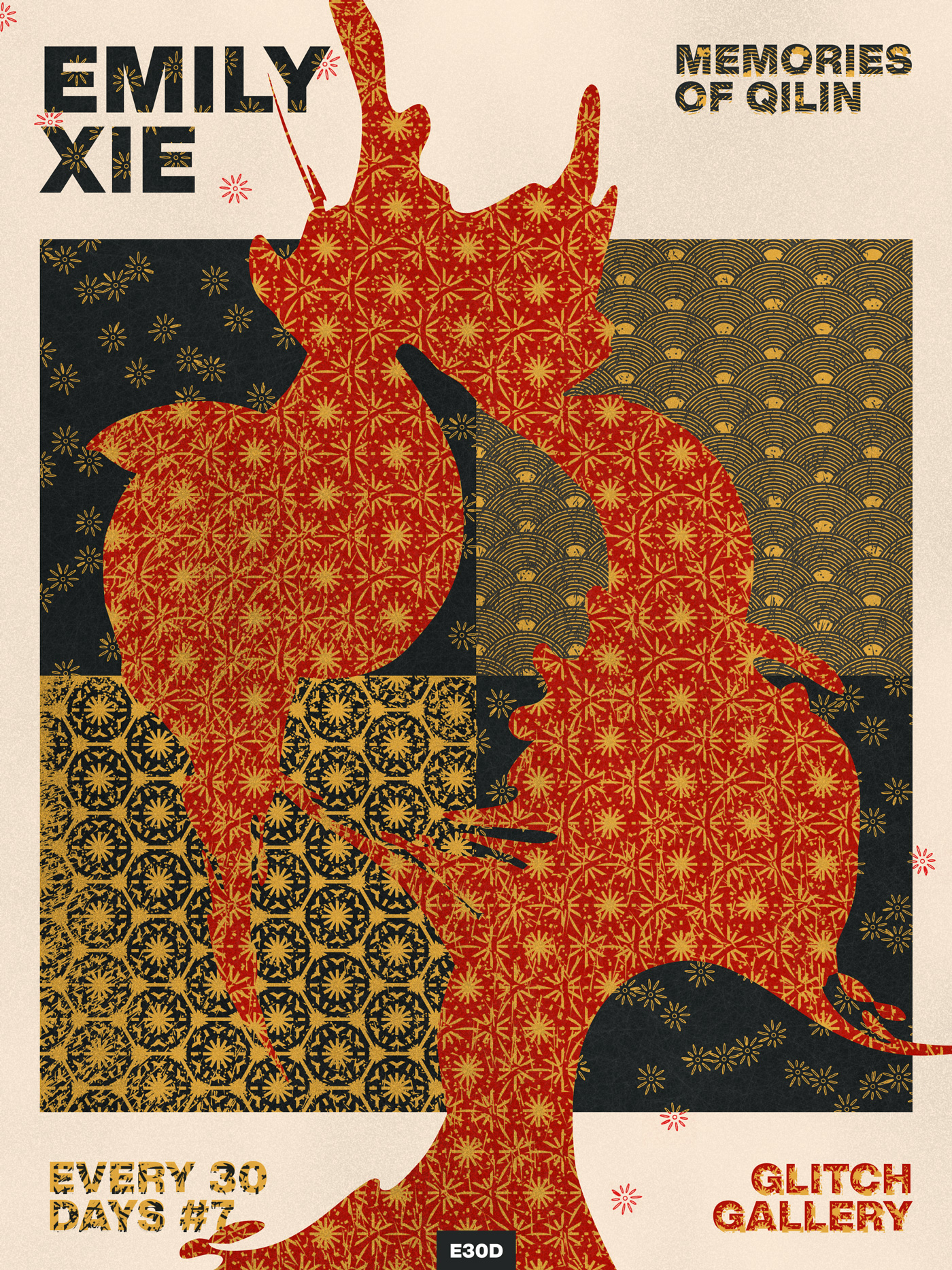Generative artist’s Emily Xie’s work is a meditation on inconclusive questions: What is organic material in light of the computer and blockchain era? If code can show organic qualities, can it be organic? Playing between the figurative and symbolic, anecdotal and historic, old and new, Xie invites viewers to live in such paradoxes in November’s Every 30 Days Exhibition: “Memories of Qilin” (2022).
To start, consider the collection title.
The qilin creature is the East Asian rendering of a chimera. Chimeras take on various parts of different animals to complete a miraculous, folkloric, contradicting existence. Versions of the mythical beasts weave their way across time and culture, with records suggesting they first appeared in art and texts from Lycia and Asia Minor between the 15th-14th centuries BC.1
Understood as a symbol for luck and good fortune, today the qilin appears on coins, visual motifs for Asian brands, contemporary iconography, and cultural objects alike. According to folklore, qilins are part of the four auspicious spirits in Chinese mythology. Kind hearted, noble and virtuous, the qilin materializes in peaceful and prosperous places, even aligning with Chinese philosopher Confucius himself. In some lore, Confucius witnessed a qilin’s birth and death; thereafter the qilin symbolized a sage-like role with its ability to predict the future.2
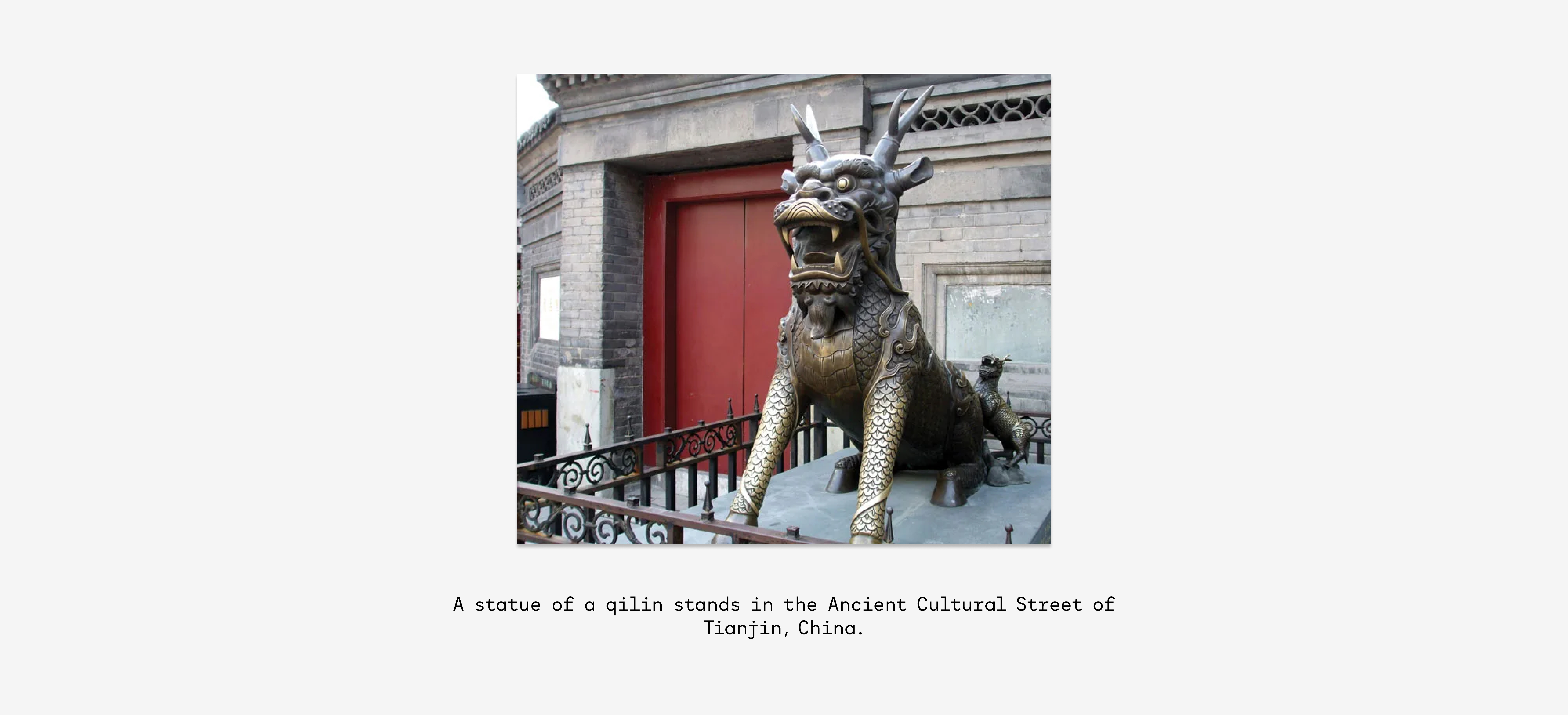
Yet, a qilin is never figuratively depicted in Memories by Xie. You won’t see a version of its physicality in any of the 1,024 outputs.
But – you do almost see it.
You almost see it as you almost see a flower, a landscape, a person, begging the question - why would a collection with such an intentional subject name be devoid of its depiction?
Because, it is the spirit of the qilin that is ever-present. We’re called to be with the collection beyond literal representations. Such is the mastery of Xie’s work, we’re compelled to dance between forms. Resembling figure ground reversal and anamorphosis techniques, the human eye tries to identify the imagery in each output.
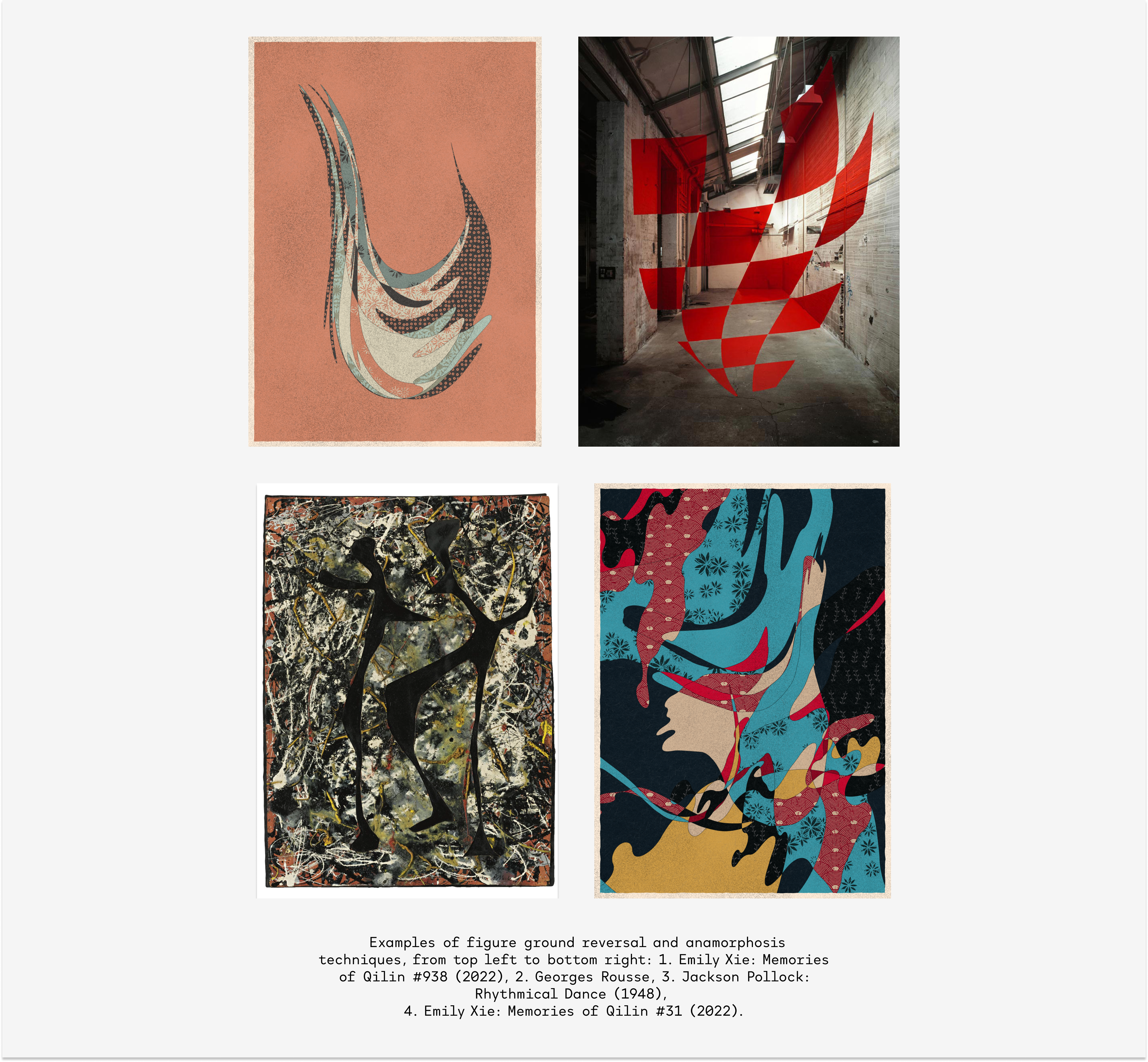
And yet, you can never quite get there.
As soon as your eyes settle and see a bird, they travel to another part of the composition and you’re looking at a night sky. Like clouds passing, you can breathe amongst the shapes and textures.
More slow dance than static image.
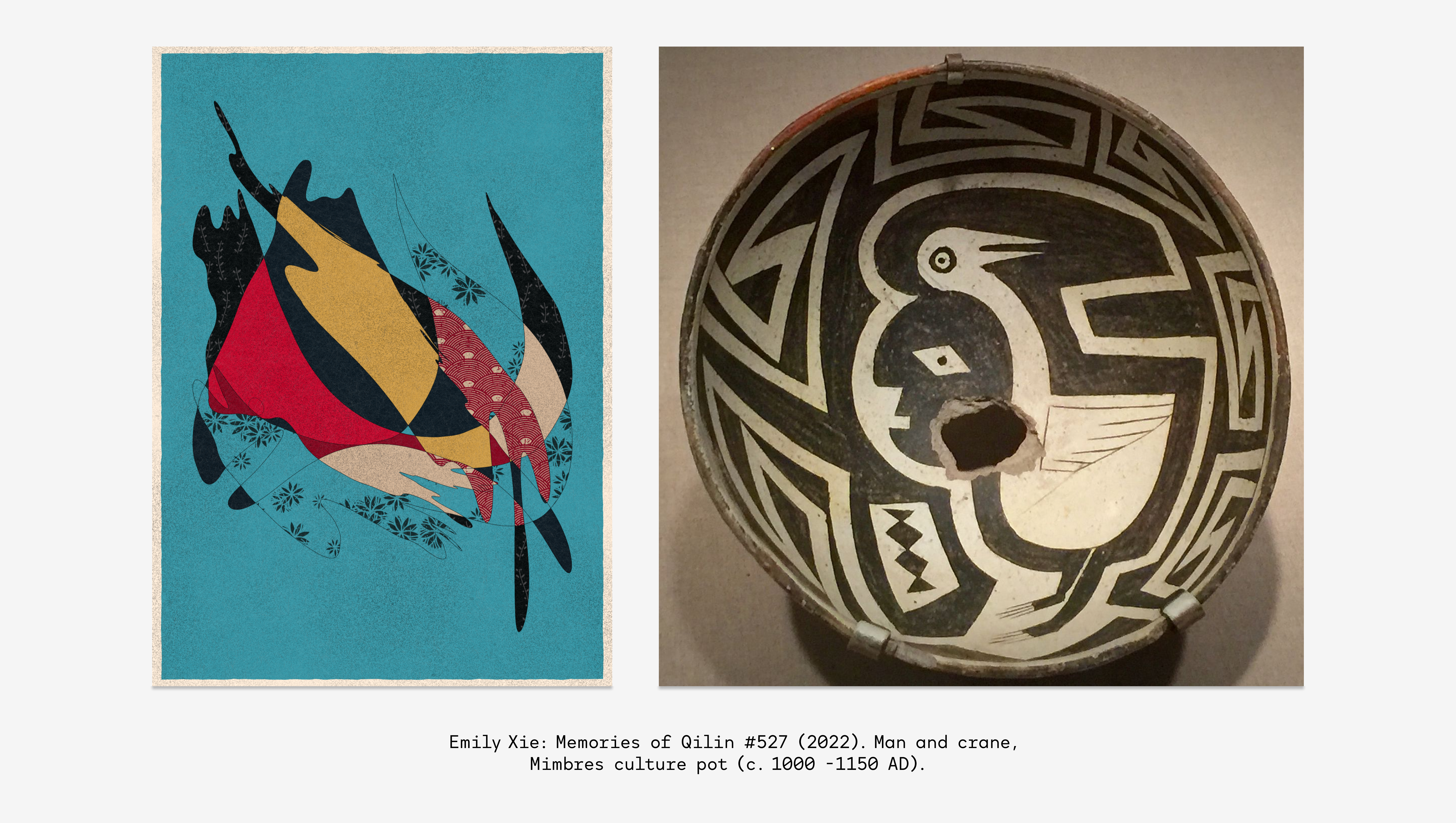
This dance from one allusion to another communicates with a form of abstract art that plays with semi-figurative expressions. Notably, Jean Dubuffet’s “Group Group of Four Trees” (1969-72), which today stands in downtown New York City, proposed a new way to relate to natural subjects and their surroundings.3
It’s as if in constructing life-sized trees he’s suggesting – “isn’t a real tree also as worthy of the attention we give this art piece?”.
Indeed, we should apply this skillful attention in contemplating the subjects in Xie’s outputs.
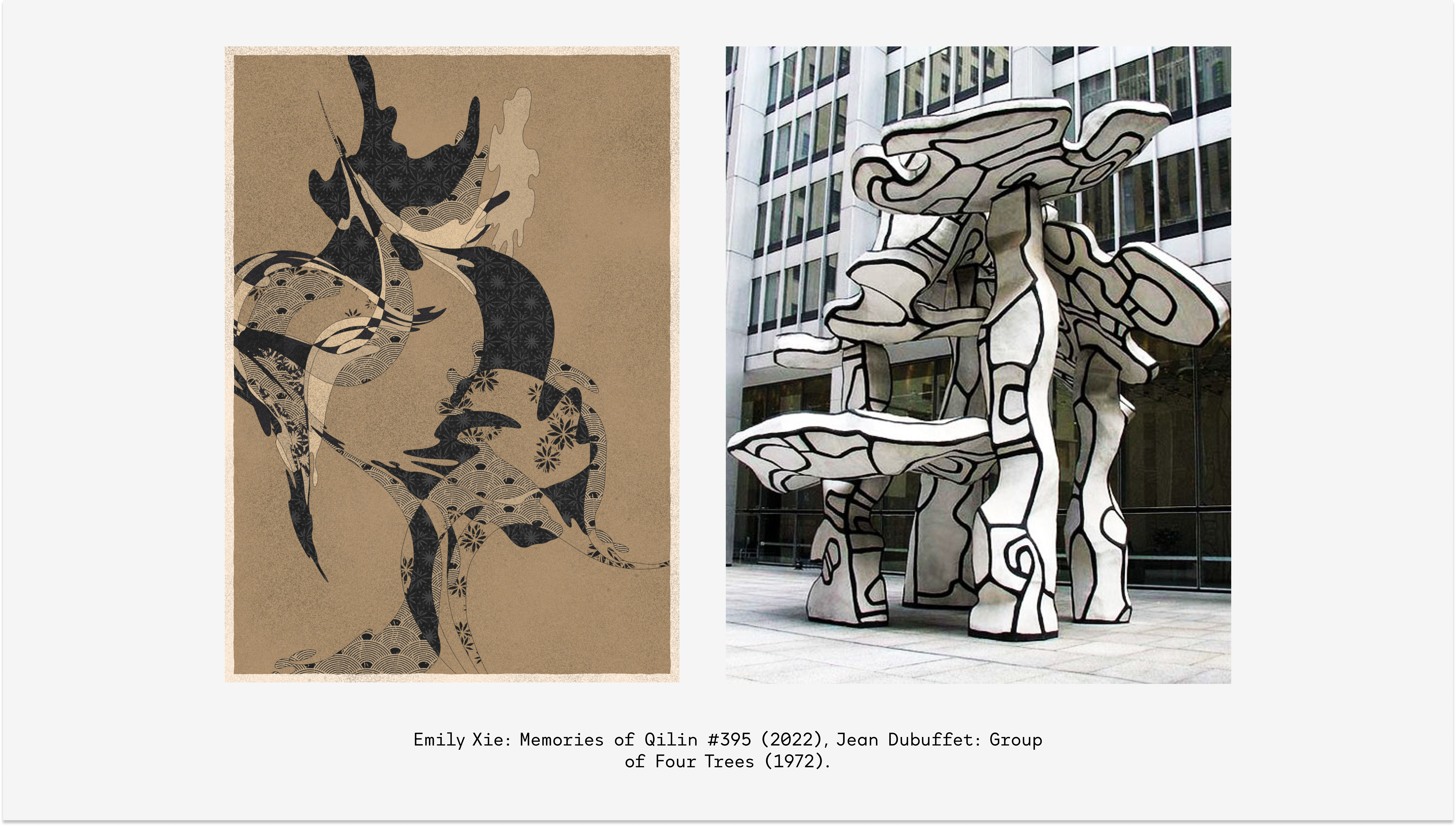
Xie’s work also explores how personal heritage can be just as abstract and contradictory in these digital compositions.
To be sure, inspiration of ukiyo-e art (Japanese painting and woodblock prints) and Chinese brushstroke arise in the aesthetics of the collection. There are patterns, there are ink splots, there are curving lines. These marks, of course, are randomly generated and assembled through Xie’s collaboration with code, representational of an unreliable relic from a past that may or may not have happened.
Rather than reading from a history book, Memories is akin to listening to an elder recount stories of her youth. You’re never sure if such tales are historically accurate, or if they ever occurred.
That’s not really the point of a good story, is it?
It’s the narrative that captivates us.
In this way, the collection symbolizes a relationship to history and heritage so many Americans share. There is a vagueness to our shared lineage, so we cling to ancestral stories as a balm to soothe their mystery. Memories of Qilin makes our invisible stories visible and valuable, affirming our personal and familial folklore is worthy of such representation.
To be sure, the collection asks the viewer to survey the intentionality behind the abstractions and symbolism. Simultaneously, it demands a widening of the aperture to study Xie’s motifs through the lens of folk and resistance art.
Existing throughout millennia - quilts are a time honored folk art almost exclusively crafted by women. Some scholars date the technique to 3400 BC based on their appearance in Egyptian iconography. Early examples of quiltmaking date back to the Medieval times in Europe, India, and The Far East. These iterations are on display at The Victoria and Albert Museum – a museum dedicated to the global history of textiles and fashion.4
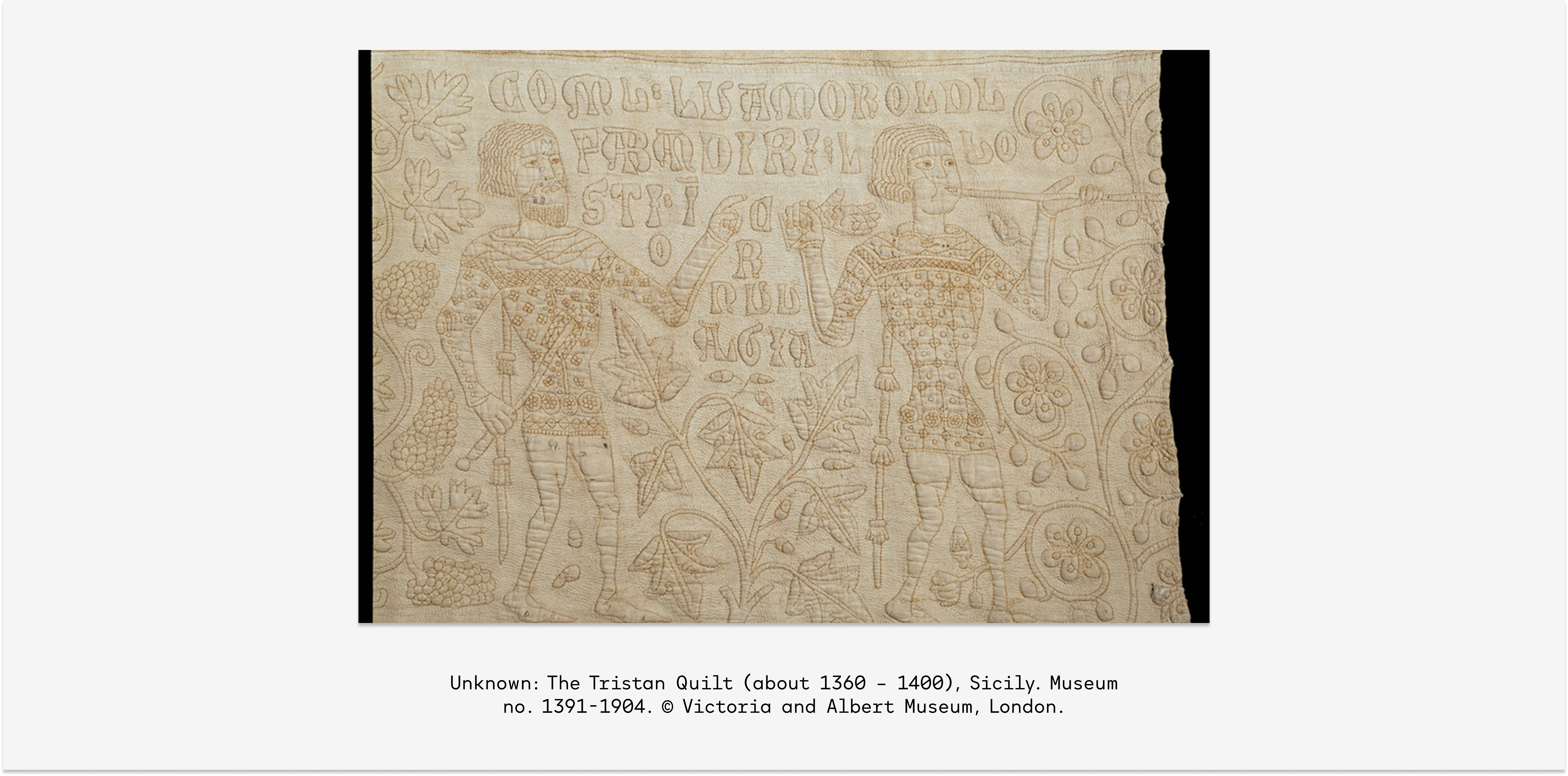
Patchwork quilts, the type of quilting created when two or more distinct pieces of fabric come together, have their own unique story. Enjoyed across cultures, locations, and historical periods – quilts were often made durable so as to be passed down from generation to generation, matriarch to matriarch.
In this way, quilting has often been understood to be a social activity – one that brings people together, allowing them to exchange ideas and preserve the legacy of their family, community, and culture. Some of the earliest and lasting examples of historical quilts exist today solely because of multi-generational sharing. However, as is so often the case with craftwork like textiles and fashion, these pieces rarely receive attention from traditional art institutions.
It is a joy, then, for us to see a craft passed down by women represented in a burgeoning tech space that still has the potential to make such art more visible.
And, an added joy that such a collection can be viewable outside of the traditional art lens, outside of institutions, and more democratically in the homes of everyone who wishes to see it on a screen.
Unlike the physical quilts from which she drew inspiration, Xie’s quilts will live on the blockchain for centuries to come without degradation, and at resolutions with far more detail than their analog counterparts.
In recent years, physical quilts and quilt iconography have become powerful tools to bring attention to pressing issues in skillful and urgent ways. We can thus rightly include Xie’s work in the canon with other artists drawing attention to domestic crafts in their practice. Notably, Tracey Emin’s “Hellter Fucking Skelter” (2001) uses the quilt motif to form memoir-like art. Paired with pink hues and bold lettering, Emin is not a quilt maker by trade. Instead, she used what is traditionally known as “women’s work”, quilting, to ensure such is visible in institutional settings.5
A strategy, to be sure.
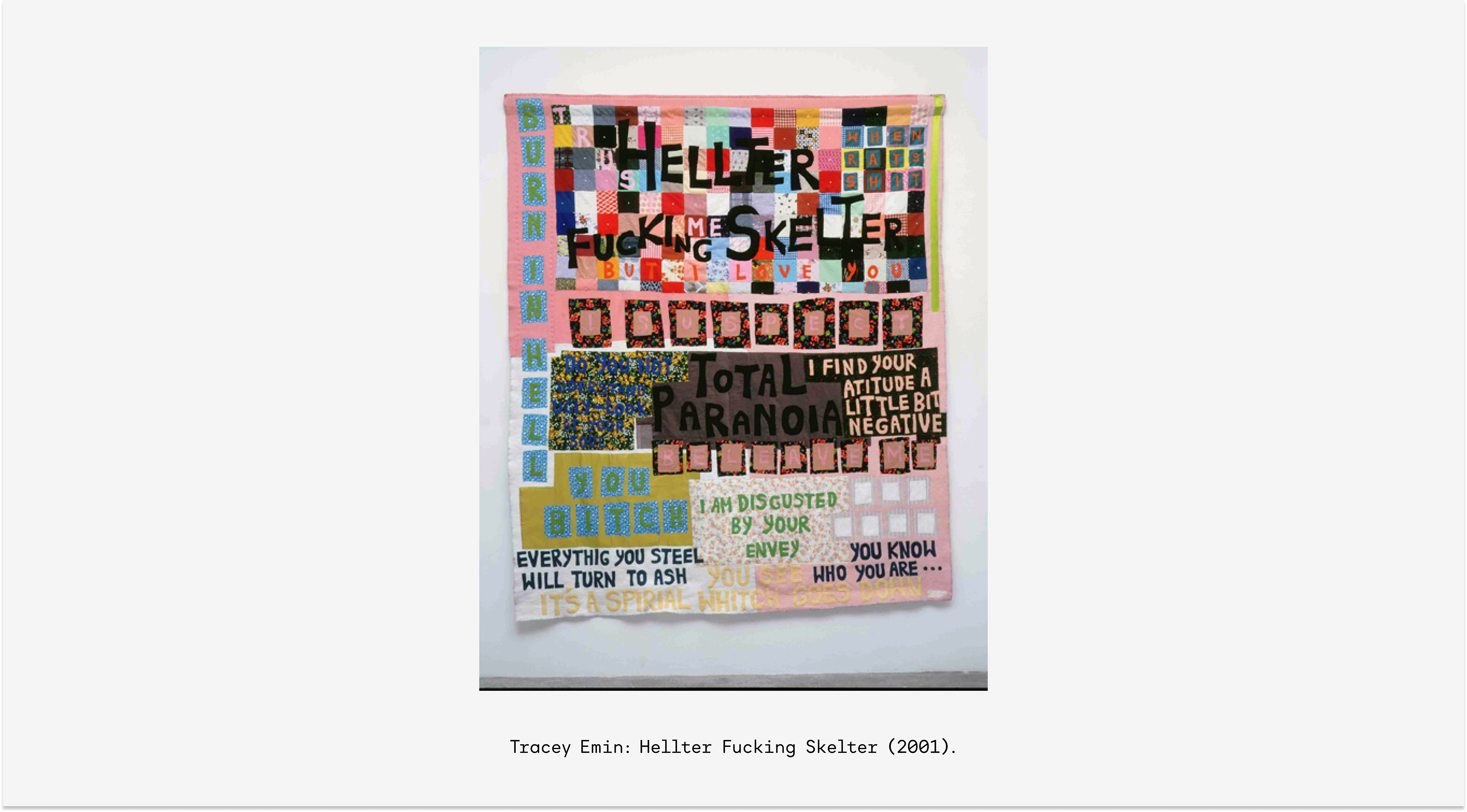
And yet, Xie’s work is of course not made from fabric, but a computer. It leads us to marvel at an astonishing contradiction - immaterial code can create a feeling of materiality.
Launching in March 2022, Xie’s Memories is a long-form generative collection of collage-based artwork, minted on the premier ‘Art Blocks Curated’ contract and platform. In constructing the work through this system, Xie’s collectors created a variety of randomized outputs around a single on chain algorithm, devised using p5.js.
Thematically, patterns arise from swirling shapes resembling asymmetrical patchwork quilts. The blanket’s feel, the star and wave-like patterns – these overlap with circular objects. Warm reds and cool blues draped together help cozy the viewer to the collection. While some pieces offer a layered tapestry quality filling the entire frame, others are more graphic and gestural, if not symbolic. The crispness of the patterns and colors lie in contrast to the moving lines of each tableau.
There is an inherent difficulty of creating something with the computer (hard edged, click-clacky, decisive) while achieving these rounded, woven, and dance-like outcomes.
As we trod along in digital spaces, as they feel more and more like our normal, what do we see as organic material? Can we feel digital objects like we feel fabric? In the end, the collection lives in these questions rather than providing us with concrete answers.
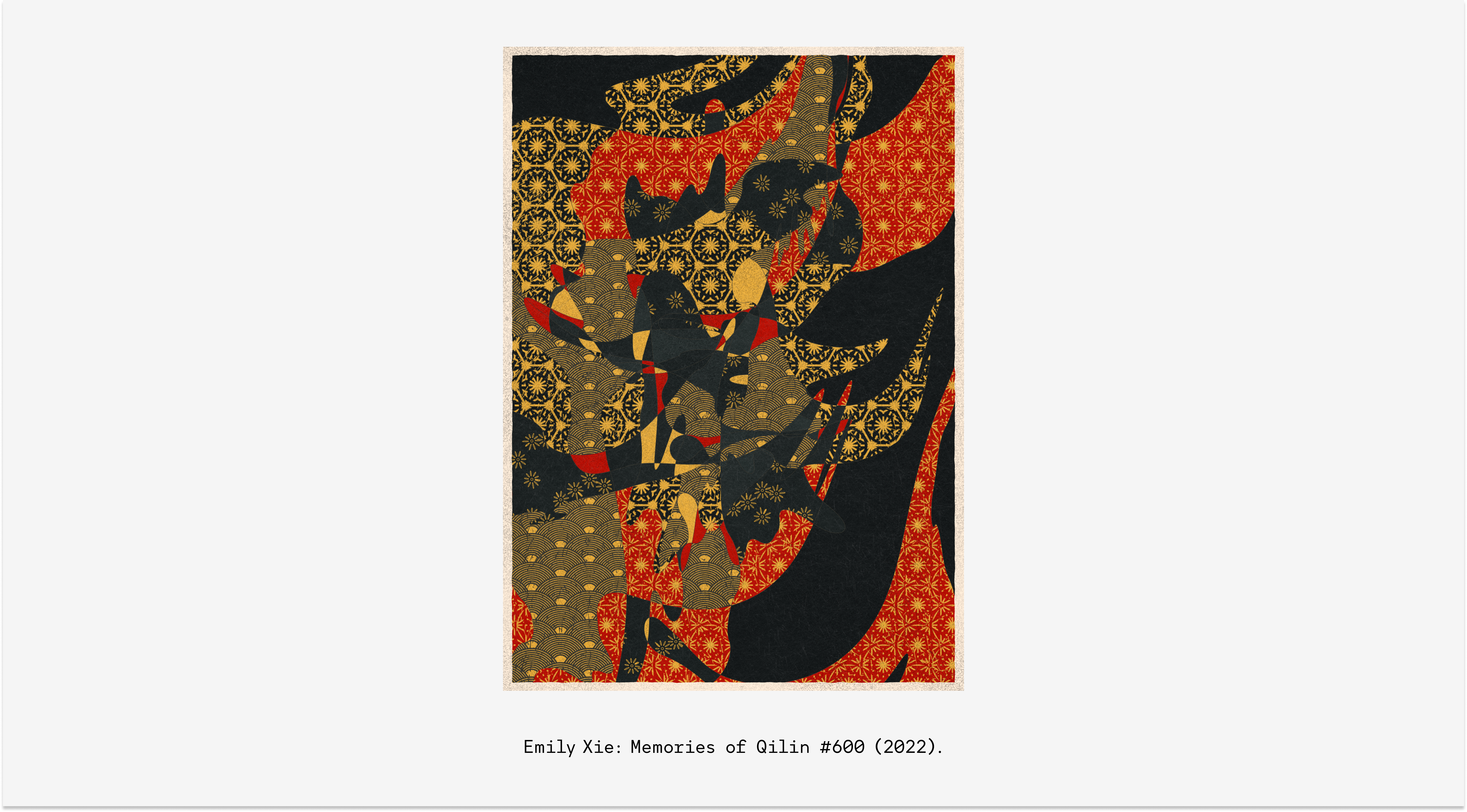
Conclusively, Memories of Qilin is a work of layers – traditional cultural and social references, quilted procedurally and on demand, immutably stored on a 21st- century global database.
In the years to come, this gallery believes Memories will be looked at as a stand-out collection embodying the chimeric nature of blockchain based art:
Stitched with code. Astonishingly contradictory. Imbued with cultural data.

Thank you to Emily Xie whose interview helped direct the research of this piece, and to collector Bob Loukas for sharing his “Memories of Qilin” collection with us. To Derek and Malte for their deeply collaborative spirits, to PixelPete and Martina Negro for their suggestions and wisdom.
And always, to DES.
-
Britannica, The Editors of Encyclopaedia. “qilin”. Encyclopedia Britannica, 2 Feb. 2023, https://www.britannica.com/topic/qilin. Accessed 30 October 2023. ↩
-
“Qilin — Mythical Creature of Benevolence, Strength, and Auspiciousness”. https://www.chinafetching.com/qilin. Accessed 17 October 2023. ↩
-
Fondation DuBuffet, “Groupe de Quatre Arbres”. https://www.dubuffetfondation.com/oeuvres/248. Accessed 20 October 2023. ↩
-
Victoria and Albert Museum, “An Introduction on Quilting and Patchwork” : https://www.vam.ac.uk/articles/an-introduction-to-quilting-and-patchwork. Accessed 20 October 2023. ↩
-
Art Image, Hellter Fucking Skelter, 2001. https://www.artimage.org.uk/5145/tracey-emin/hellter-fucking-skelter–2001. Accessed 10 October 2023. ↩
